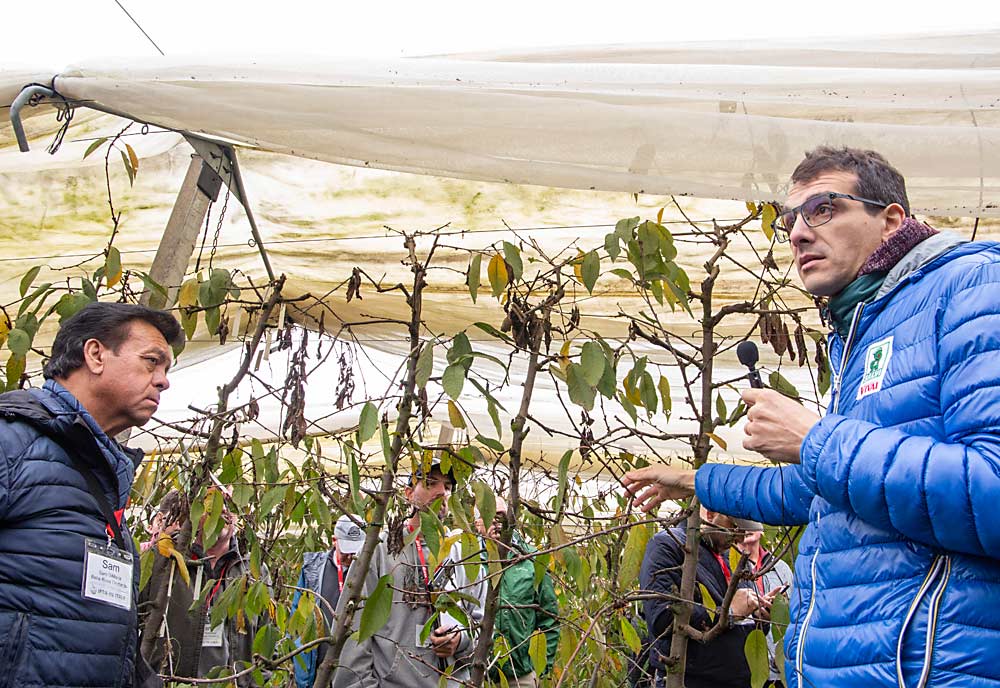
An Italian cherry orchard in the Po River Valley takes high-density planting to new levels.
Blocks of Kordia, Ferrovia and Regina are planted at 2,672 trees per acre in a system aptly named super-high-density spindle. Even for progressive European standards, that’s a lot of trees.
The orchard at Salvi Vivai in Ferrara was one of the stops on the International Fruit Tree Association tour of Italy in November. While North American participants didn’t return home with plans to replicate the orchards, they gleaned a few management lessons.
The Italian company, which also grows kiwifruit, strawberries and apples, planted the ultra-dense orchard to establish a consistent harvest by the second year and reach full production by the fourth year, said Jacopo Diamanti, research and development manager. They don’t manage all their cherries this way, Diamanti said, but keep the small plots for grower demonstrations.
Researchers from the nearby University of Bologna, which steered establishment of the orchard in 2014, have calculated that the system will begin to pay for itself in the seventh year, including the cost of netting, trellises and labor. The company used Gisela 5 rootstocks with roughly 11 feet between rows and 18 inches between trees.
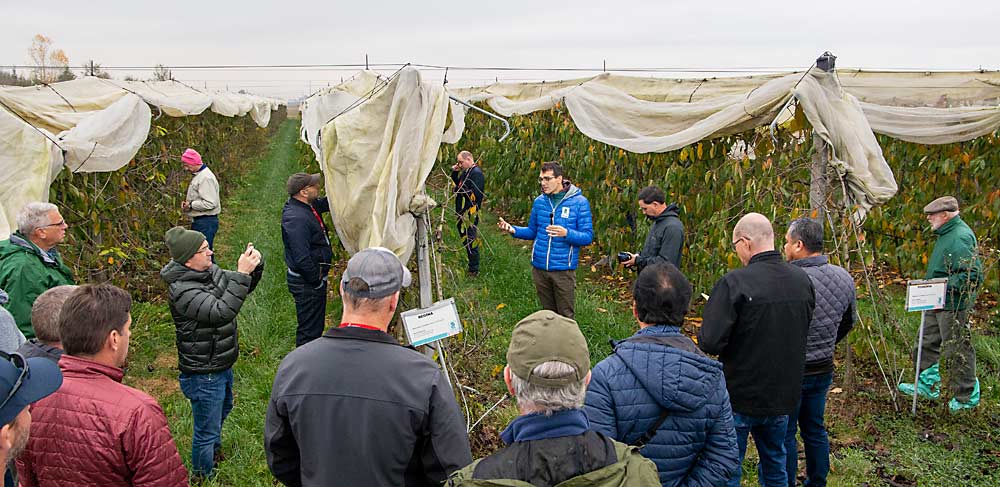
The orchard produces at least 6.25 tons per acre, Diamanti said. The trees would produce more, but he recommends growers stop there to keep fruit size large. At that volume, at least 70 percent of the fruit will reach the target size of 28 millimeters in diameter, about a 9.5 row size.
And Salvi Vivai knows large fruit. In 2021, the company briefly held the Guinness World Record for largest cherry — weighing 26-plus grams.
To start the orchard, company crews made only top cuts the first year. In the second year, they pruned to stimulate side branches and fertilized aggressively. The trees produced 1–1.5 tons per acre.
“Which is not bad for a second year’s harvest, in our opinion,” Diamanti said.
Now that the trees are mature, crews renew branches each year. Ongoing pruning requires two cuts between each season. In November, crews prune partway to slow down branch growth. In February or March, they return to cut the same branch down to four buds.
Meanwhile, Salvi Vivai also uses nets in unusual ways. First, workers double-net the top of the canopy over a bullhorn post for rain protection, almost like holding an umbrella over the trees. The region receives enough rain that many orchards have drainage trenches between rows.
For the sides, they pull down a fine mesh netting to exclude spotted wing drosophila, from which they have high pressure. The mesh is fine enough to keep out the tiny flies, but workers can still spray through the nets to treat the trees with fungicide or other chemicals, Diamanti said.
He estimated the system would cost $35,200 per acre, including tree royalties, netting and labor.
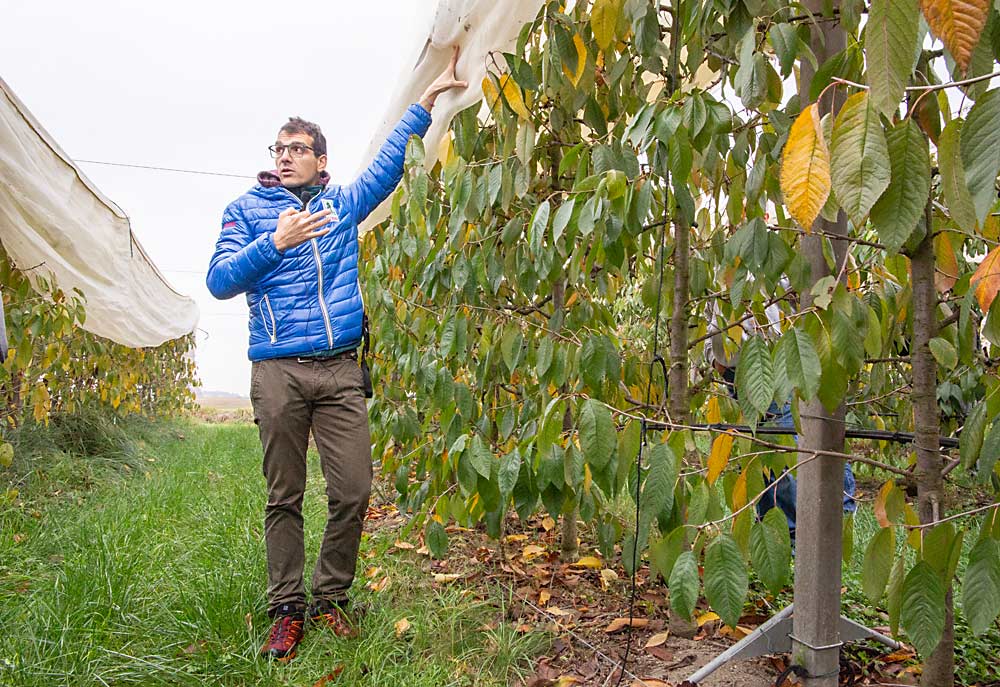
Northwest reaction
A few growers from the Northwest, the United States’ largest cherry-producing region, said the Italian system offers some lessons but would not make sense to replicate.
For one, 6 tons per acre is not high enough volume, said Mark Hambelton, a Quincy, Washington, cherry grower who participated in the Italy tour.
“I don’t think you can realistically farm if you’re not getting 9 tons or more per acre,” he said.
As for netting, he would find more value in exclusion of the leafhoppers that transmit X disease rather than spotted wing drosophila.
Betsy Beers, a Washington State University entomologist, knows of cherry growers using nets to keep out birds but not insect pests, she said. She has studied exclusion netting for apple pests, such as codling moth, but has not been approached about conducting similar research for cherries.
Arid Central Washington, where most of the Northwest’s sweet cherries grow, has economic pressure from spotted wing drosophila, but it’s not as high as in other parts of the U.S., such as the Mid-Atlantic or in Michigan, she said.
Sam DiMaria of Kelowna, British Columbia, also doubted the super-high-density system would replicate well in the Northwest, though he favors dense plantings and planar systems for ease of management, he said.
For one thing, current rootstocks will only take growers so far, said DiMaria, a frequent IFTA traveler who has visited Italian orchards several times. Growers in different regions of North America are running commercial trials now at similar densities with dwarfing rootstocks from Michigan State University.
Even with Gisela rootstocks, which are more dwarfing than Mazzards, growers must manage carefully to maintain large fruit size.
“You really have to be a crackerjack manager,” DiMaria said.
Denny Hayden, a Pasco, Washington, grower, has one of those MSU trials with rootstocks planted 18 inches or 2 feet apart. He still is determining how that will affect long-term fruit quality.
U.S. researchers have explored high-density plantings through NC-140 rootstock trials for more than a decade, said Michigan State University’s Greg Lang, one of the tour organizers.
“It was clear that it would not work on our trials with Gisela 6,” Lang said of one of the Northwest cherry industry’s favorite rootstocks. “It looked good with Gisela 3.” Lang previously worked at Washington State University.
The system also is variety dependent, according to research. It would require varieties that push a lot of lateral branches and flower at the base of those branches, he said. Those blooms set high-quality fruit but low yields.
Meanwhile, labor would be cost-prohibitive, and the tight netting system would restrict airflow and cause heat damage, he said. In fact, he has seen that happen in that Italian orchard during a previous visit.
“I don’t think it’s going to be adopted significantly in the U.S.,” Lang said.
Still, times could change, said Jeff Cleveringa, an IFTA board member and one of the tour leaders. Maybe someday Washington growers will look for a new district where some of the Italian techniques, either the density or the netting, makes more sense. Those lessons may come in handy yet, he said, “even if it’s not perfect and it doesn’t fit exactly.”
—by Ross Courtney

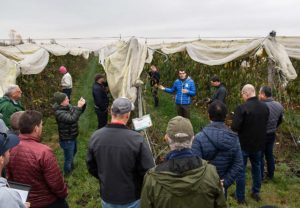
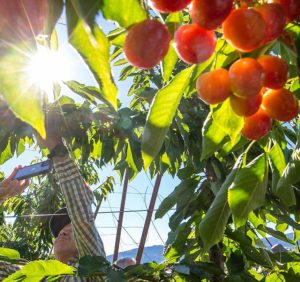





Leave A Comment